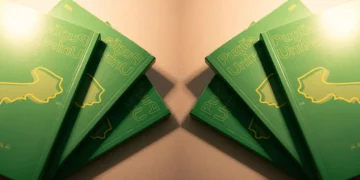
Latest exhibition by Titus Kaphar, “Exhibiting Forgiveness,” opens on September 13 at the Gagosian gallery in Beverly Hills, showing a collection of new paintings that play a central role in Kaphar’s debut narrative feature film of the same name, which will be released in theaters on October 18. The film, semi-autobiographical in nature, narrates the story of Tarrell Rodin, a painter whose life is disrupted by the reappearance of his estranged father. The intimate relationship between Kaphar’s art and his film underscores the multifaceted narrative he has created, where both mediums enrich and expand upon each other’s themes.

The paintings featured in “Exhibiting Forgiveness” are not mere visuals that accompany the film but are integral to its storytelling. They serve as visual metaphors that capture the emotional landscape of the characters and plot. Kaphar employs a variety of techniques, blending traditional oil painting with unconventional materials like gold leaf and tar. These materials symbolize the duality of divine aspiration and earthly struggles, echoing the film’s exploration of the human condition. By incorporating these elements, Kaphar challenges traditional representations and encourages viewers to engage with the complex interplay of personal and collective memory.
EXHIBITIONS
One of the compelling aspects of Kaphar’s work is how he uses color and texture to evoke emotional responses. Some paintings in the exhibition are vividly colored, using purples, reds, blues, and yellows reminiscent of his previous series, “From a Tropical Space”. In contrast, other works are deliberately drained of color or feature physical cutouts, representing absence and loss. This manipulation of color and form reflects the themes of trauma and healing that are central to the exhibition. The visual language Kaphar develops through his paintings mirrors the narrative progression of the film, creating a dialogue that invites viewers to contemplate the nature of forgiveness.

The narrative of this project is deeply personal, drawing parallels with Kaphar’s own experiences. The artist has long explored the themes of estrangement and reconciliation, as seen in his earlier project, “The Jerome Project”. By expanding these themes into a film, Kaphar not only revisits the past but also reimagines the possibilities of healing and renewal. The film’s protagonist, Tarrell, portrayed by André Holland, navigates the complexities of reconciling with a parent who has been absent due to addiction. Kaphar’s decision to tell this story through both film and painting demonstrates his commitment to using multiple forms of media to explore difficult, often painful, subjects.

In addition to its narrative and thematic richness, “Exhibiting Forgiveness” exhibition by Titus Kaphar at the Gagosian also stands out for its technical and artistic innovation. Kaphar’s application of mixed media within his paintings introduces a textural complexity that engages viewers on a tactile level. His use of knife-cut excisions, for instance, is more than an artistic choice; it is a deliberate act that communicates themes of removal, absence, and the impact of memory. The physicality of these excisions adds a layer of depth to the paintings, inviting viewers to consider what is left behind and what has been taken away.

The upcoming publication by Gagosian will further illuminate Kaphar’s creative process, providing insights into both the film and the paintings. The book will feature reproductions of the exhibited works, stills from the film, and excerpts from the script, offering a comprehensive look at how Kaphar interweaves his roles as painter and filmmaker.



















